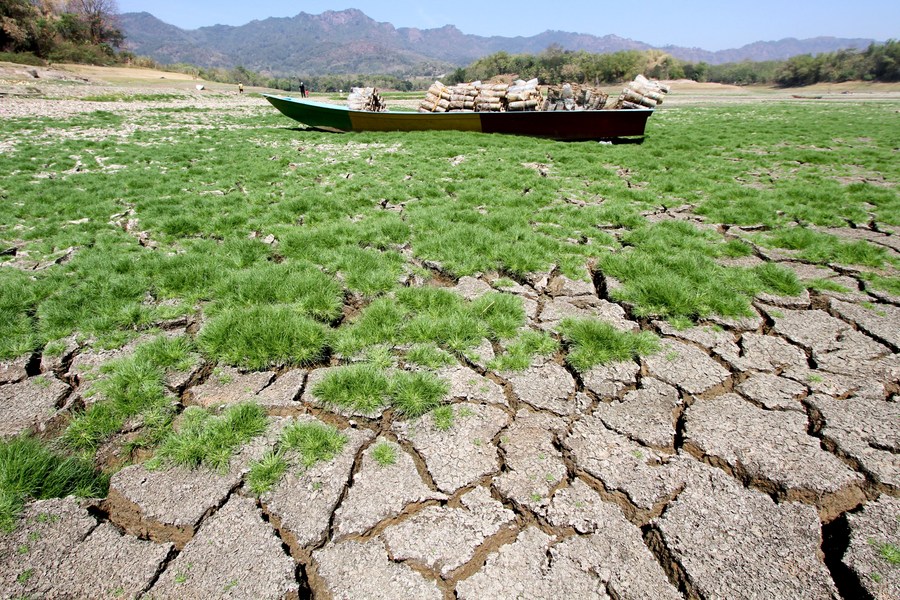
A wooden boat is seen on dry bed of a reservoir in Wonogiri district, Central Java, Indonesia, Aug. 10, 2023. (Str/Xinhua)
For years, developed countries in the West, including the United States, disregarded their historical responsibility on climate change in their highly industrialized development.
BEIJING, Dec. 7 (Xinhua) -- Taking responsibility and delivering on promises on climate change is a hot topic at the ongoing 28th session of the Conference of the Parties to the United Nations Framework Convention on Climate Change (COP28) in Dubai.
For years, developed countries in the West, including the United States, disregarded their historical responsibility on climate change in their highly industrialized development, marked by high energy consumption, heavy pollution, and high carbon emissions over centuries.
They disregard their moral duty and legal obligation to compensate affected developing countries and coerce them into accepting irrational emission reduction plans.
Such action, dubbed as "carbon colonialism," has severely undermined global determination and progress in tackling climate change.
Climate change knows no borders. It is imperative to discard outdated colonial logic and take shared but differentiated responsibility on climate change so as to shape a sustainable global future.
MAJOR EMITTERS IN HISTORY
Greenhouse gas emissions on a global scale can be traced back to Western industrialization. Developed nations, including the United States, historically followed an extensive development model, producing most of the global carbon dioxide and greenhouse gas emissions.
Data show that from the beginning of the Industrial Revolution in the mid-18th century to 1950, developed countries emitted 95 percent of the world's total carbon dioxide, and from 1950 to 2000, the emissions produced by developed countries accounted for 77 percent of the global total.
At present, developed countries continue to produce notably high carbon dioxide emissions. A study led by the University of Leeds, published in June in the journal Nature Sustainability, exposed that nearly 90 percent of excess carbon emissions have originated from developed nations.
In terms of carbon dioxide emission per capita (metric tons), despite the reduction of carbon emissions by developed countries in recent years, their per capita carbon emissions still far exceeded the global average. In 2016, the United States registered a per capita carbon dioxide emissions of 15.32 tons, more than three times the global average of 4.76 tons.
According to a research study published in the Lancet in 2020, as of 2015, the United States had contributed 40 percent of the world's total overshoot emissions. Noting that this proportion can be employed to gauge the extent of national responsibility for emissions surpassing the global planetary boundary, the study said the United States is, therefore, responsible for 40 percent of the global climate breakdown.
The findings demonstrate that high-income countries bear a substantially higher degree of responsibility for climate damage than one might expect by looking simply at current or cumulative national territorial emissions, it added.
The findings "are of particular importance for lower-income countries that suffer disproportionately from climate damage despite not having contributed to excess emissions at all," said Jason Hickel, author of the article.

This photo taken on June 27, 2023 shows a thermometer at a residential backyard in Plano, Texas, the United States. (Photo by Dan Tian/Xinhua)
Pioneer industrialized nations, such as the United States, should have borne major historical and global responsibility for climate change, and their goals should encompass achieving net zero, even negative carbon emissions at an early date and repaying historical debts.
However, in international climate negotiations, developed countries played down historical responsibilities, demanded equal emission reductions, and disregarded "carbon debts," which further aggravated the imbalance between the rights and obligations of developed and developing countries on the issue of climate change.
According to a research paper published in the journal Nature Sustainability, high-carbon countries owe at least 192 trillion U.S. dollars to low-emissions nations in compensation for their greenhouse gas pollution. Of this total, 89 percent (170 billion dollars) corresponds to the Global North countries, with the United States alone being responsible for 80 trillion dollars.
OUTSOURCING CARBON EMISSIONS
While the United States and other developed nations have thrived on climate colonialism, they have also outsourced pollution-heavy production through globalization in recent decades, transforming direct carbon emissions into indirect ones. However, in their carbon emission calculations, they exclude the emissions embedded in their consumption and investments.
As early as 1972, the United Nations Conference on the Human Environment held in Stockholm proclaimed that in developing countries most of the environmental problems are caused by under-development. Developing countries prioritize survival, development, and national rejuvenation. Carbon emissions, closely linked to production, and emission quotas, represent a form of "development rights."
Consequently, the carbon outsourcing practices of developed nations have not only hindered the sustainable development of developing countries but also burdened them in the realm of climate change.
Furthermore, developed nations, such as the United States, not only shifted their carbon emissions to developing countries in international trade, but also endeavored to offload emission reduction expenses onto these nations through unilateral carbon border adjustment mechanisms. This dual exploitation placed businesses in developing countries under the burden of both pollution and carbon tax barriers.
Actually, both Carbon Border Adjustment Mechanism (CBAM) recently introduced by the EU and the similar policy currently under consideration in the United States are seeking to use developing countries at the lower end of the global industrial chain to safeguard the interests of developed nations.
According to an article carried by Carnegie Europe in May, most of the countries most affected by CBAM, are either low-income countries in Africa or the least developed countries or developing countries in the EU's neighborhood. Such a mechanism not only contravenes the principle of development right, but also violates the principle of common but differentiated responsibilities.
The decision to impose such taxes on developing countries reflects the colonial practice of transferring wealth from the developing world to the developed one. Without due consideration of historical harms, carbon border adjustments perpetuate a cycle in which the developing world suffers from the actions of the developed one, said an article published in MIT Technology Review in 2020.
"To actively promote such fossil-fuel development and then punish developing countries for emissions through carbon border adjustments is, at best, hypocritical. It's also unjust. After all, these same forces of globalization helped the developed world shift manufacturing and outsource its associated pollution burdens to China and other developing countries," it said.

This photo taken with a mobile phone on Aug. 8, 2023 shows smoke clouds of wildfires near downtown Lahaina, Maui, Hawaii, the United States. (Photo by Alex Freeman/Xinhua)
HOLLOW RHETORIC
Alleviating the impacts of global climate change, including disasters like droughts, wildfires, and floods, faces growing hindrances in developing countries due to financial constraints.
The Paris Agreement explicitly outlines the responsibilities and obligations of developed nations to contribute to climate funds, climate adaptation funds, even loss and damage funds.
In this context, however, developed nations often fall short of fulfilling their duties on emission reductions and support for developing countries.
In 2009, developed countries agreed to mobilize 100 billion dollars per year by 2020. This deadline was then extended to 2025 when a new global climate finance goal is to be set. Developed countries then hailed the agreement as a seminal commitment that would ensure that developing countries in the Global South were also able to tackle climate change. However, this goal has never been achieved.
According to the UN Environment Programme Adaptation Gap Report 2023 published on Saturday, the modeled costs of adaptation in developing countries are estimated at 215 billion dollars per year this decade. The adaptation finance needed to implement domestic adaptation priorities is estimated at 387 billion dollars per year.
Despite these needs, public multilateral and bilateral adaptation finance flows to developing countries declined by 15 percent to 21 billion dollars in 2021, and the current adaptation finance gap is estimated at 194-366 billion dollars per year, said the report.
Though the COP28 launched a Loss and Damage Fund to support the world's particularly vulnerable countries, and several countries have made their financial commitments to the fund, given the speed and impact of climate change, current efforts could hardly narrow the gap in adaptation funding.
In addition to financial support, access to sustainable and clean energy technologies is vital for developing countries. However, developed nations, holding patents for these technologies, often hindered their transfer under the guise of protecting intellectual property. This prompted developing countries to buy technologies or invest heavily in independent research, driving up the costs for jointly addressing climate change.
Climate change admits no borders. Concerted efforts towards low-carbon, green development, and proactive climate change mitigation are a shared responsibility of all nations. Developed countries must acknowledge historical realities, fulfill their obligations, and genuinely take the shared but differentiated climate responsibility to build a sustainable global future.■












